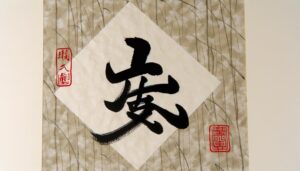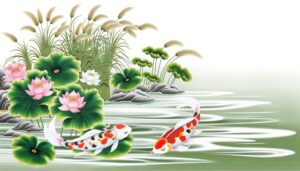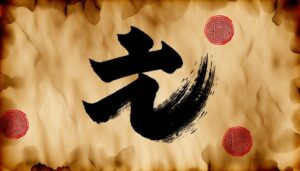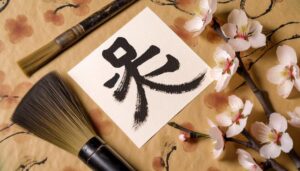Incorporating the Chinese Dragon Symbol in Home Decor
The Chinese symbol of the dragon is deeply embedded in Chinese history and mythology. Tracing back to the Neolithic period, dragons are seen as divine creatures symbolizing imperial authority, cosmic energy, and the yang principle.
In art, dragons are depicted with intricate scales and dynamic poses, often symbolizing power and protection. Literature reveres them for their wisdom and moral virtue.
As one of the twelve zodiac signs, dragons represent charismatic leadership and resilience. Their auspicious presence extends to Feng Shui, where they attract prosperity and harmony.
Explore further to understand the dragon's enduring significance in Chinese culture.
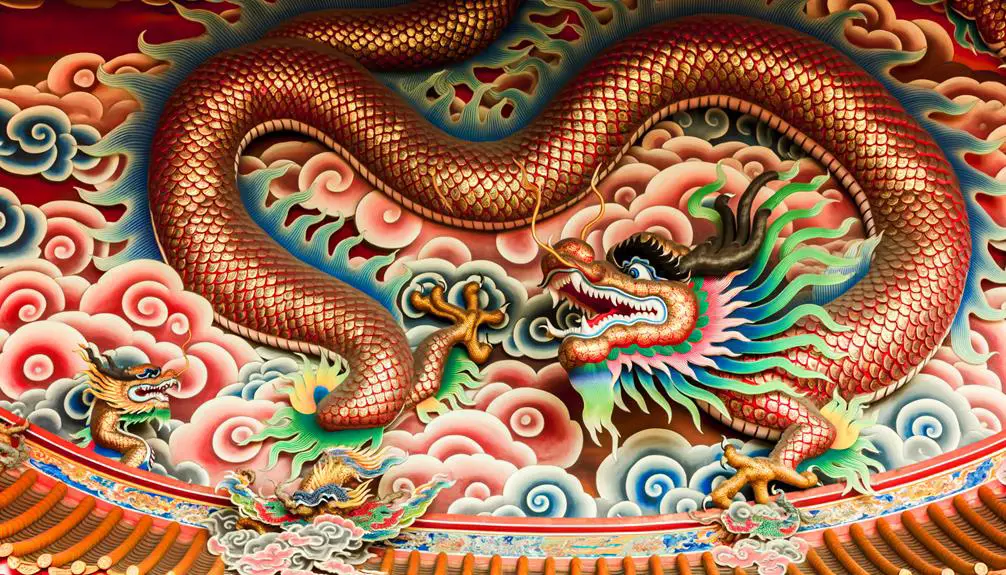
Key Takeaways
- The dragon symbolizes cosmic energy, yang principle, and imperial power in Chinese culture.
- Historically, emperors claimed descent from dragons, reinforcing their divine right to rule.
- Artistic depictions of dragons feature intricate scales and dynamic poses, symbolizing balance and protection.
- Dragons are central to Chinese mythology and literature, representing wisdom, power, and moral virtue.
- In Feng Shui, dragons attract prosperity and good fortune by enhancing spatial harmony with positive chi flow.
Historical Origins
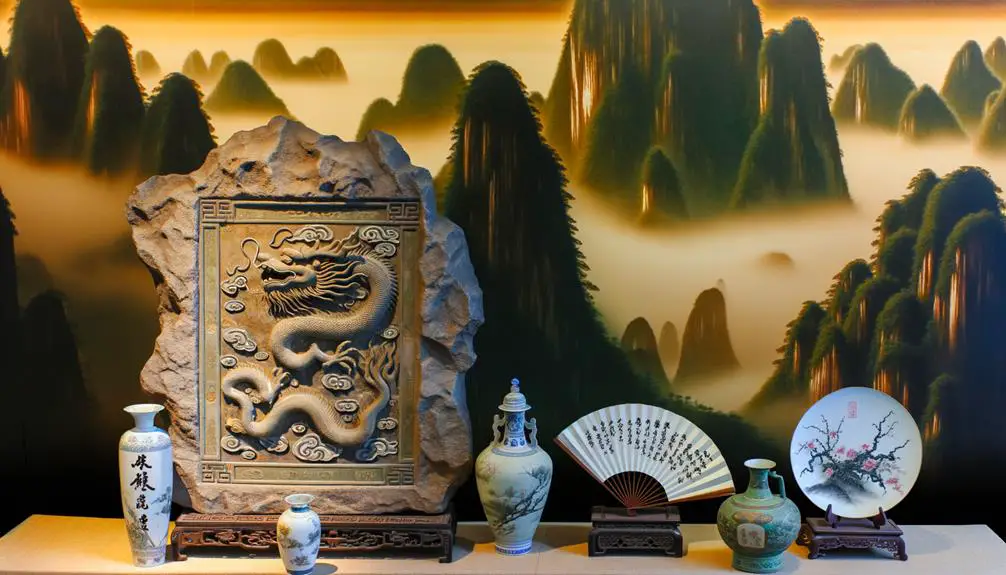
Tracing back to ancient Chinese mythology, the historical origins of the dragon symbol are deeply rooted in the cultural and spiritual traditions of early Chinese civilization. Archaeological findings suggest that the dragon motif appeared as early as the Neolithic period, around 5,000 BCE, evidenced by jade and pottery artifacts.
This symbol likely evolved from totemic representations of various animals, amalgamating features of serpents, fish, and other creatures to embody a composite being. The dragon's imagery was further solidified during the Shang and Zhou dynasties, appearing prominently in bronze works and oracle bone inscriptions.
These early depictions underscore the dragon's integral role in rituals and its association with kingship, power, and cosmic order, laying the groundwork for its enduring cultural significance.
Mythological Significance
The mythological significance of the dragon in Chinese culture is profound, encompassing themes of creation, protection, and divine authority that have been perpetuated through centuries of folklore and religious beliefs.
Revered as a symbol of cosmic energy, the dragon is often associated with the yang principle, representing strength, vigor, and auspiciousness.
In creation myths, dragons are credited with shaping the land and controlling water, reflecting their integral role in sustaining life.
Chinese emperors historically claimed descent from dragons, legitimizing their rule through divine right. Moreover, dragons are guardians of treasure and wisdom, embodying the protection of both material and spiritual spheres.
These multifaceted roles underscore the dragon's enduring significance in Chinese mythological and cultural consciousness.
Symbolism in Art
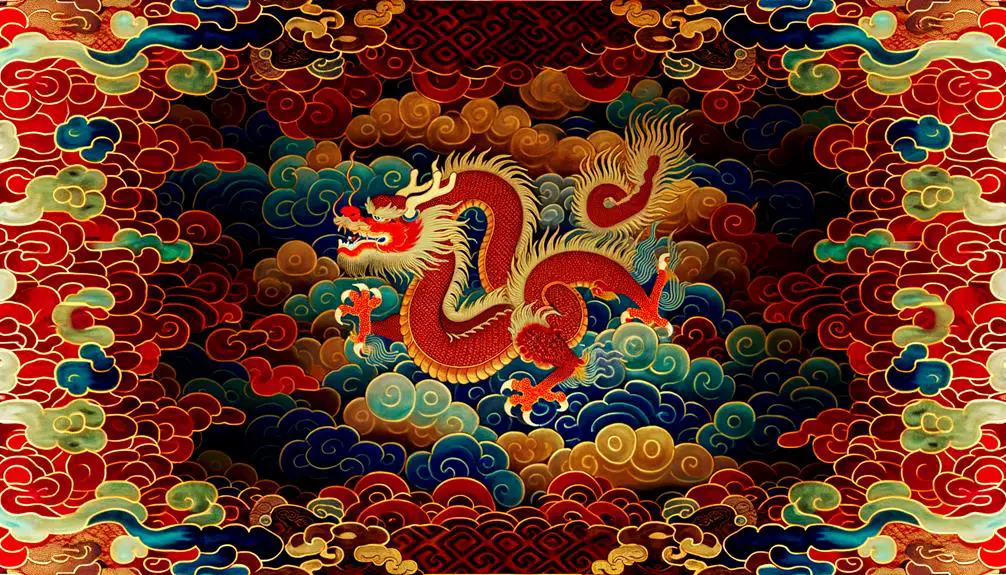
In Chinese art, the dragon serves as a significant symbol of imperial power, spiritual energy, and auspicious fortune. It is frequently depicted with intricate scales and dynamic poses to convey its majestic and otherworldly nature. The dragon's representation often includes five claws, symbolizing its exclusive association with the emperor, while four-clawed dragons denote nobility.
This motif appears in various mediums such as porcelain, silk tapestries, and architectural ornamentation, demonstrating versatility and cultural resonance. The dragon's presence in art transcends mere decoration, embodying profound cosmological beliefs and historical reverence.
Through the dragon, artists communicate themes of balance, authority, and protection, making it a central icon in the visual lexicon of Chinese culture, evoking both reverence and aesthetic admiration.
Role in Literature
Chinese literature reveres the dragon as a multifaceted symbol, often embodying themes of power, wisdom, and moral virtue across classical texts and folklore. This majestic creature appears in numerous literary forms, ranging from poetry to historical chronicles, symbolizing the emperor's supreme authority and the cosmic balance of yin and yang. The dragon's role in literature is meticulously detailed, reflecting its deep-seated cultural significance and philosophical underpinnings.
| Literary Work | Dragon's Symbolism |
|---|---|
| *Shan Hai Jing* | Guardian of Waters |
| *Journey to the West* | Protector and Guide |
| Tang Dynasty Poetry | Emblem of Sovereignty |
These representations illustrate the dragon's pervasive influence and its enduring presence in Chinese narrative traditions.
Zodiac Connection
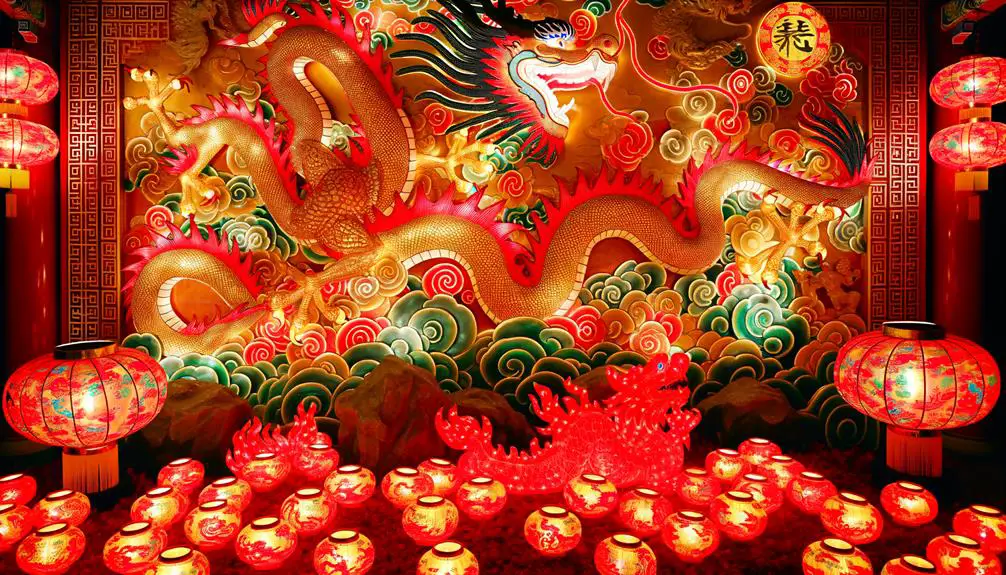
In the Chinese zodiac, the dragon is emblematic of power, authority, and a dynamic personality, reflecting distinct traits such as ambition, confidence, and enthusiasm.
This culturally significant symbol continues to influence contemporary practices and beliefs, underscoring its persistent relevance in modern Chinese society.
Moreover, the dragon's compatibility with other zodiac signs reveals intricate relationships and social dynamics, enriching our understanding of its broader cultural impact.
Personality Traits Explained
Embodying qualities of strength, ambition, and mystery, the dragon in the Chinese zodiac is often revered for its dynamic personality traits, which are deeply rooted in ancient cultural beliefs and astrological interpretations.
Individuals born under the dragon sign are frequently described as charismatic leaders. Naturally influential, they possess an innate ability to inspire and lead others.
Dragons are also intellectually curious, exhibiting a remarkable thirst for knowledge and a penchant for intellectual pursuits.
Fiercely independent, they value their autonomy and often prefer to carve their path, unburdened by external constraints.
Moreover, dragons are resilient and tenacious. They face challenges head-on, demonstrating remarkable resolve and persistence.
These traits collectively contribute to the dragon's esteemed position within the Chinese zodiac, symbolizing a potent blend of power and enigma.
Cultural Significance Today
Building upon the dragon's dynamic personality traits, its cultural significance in contemporary society remains profound, particularly through its enduring connection to the zodiac. In the Chinese zodiac, the dragon symbolizes power, authority, and good fortune. As the only mythical creature in the zodiac, it holds a unique status that transcends mere symbolism, embodying aspirations for greatness and success.
Celebrated during the Dragon Boat Festival and other cultural festivities, the dragon's presence reinforces collective identity and cultural continuity. Additionally, individuals born in the Year of the Dragon are believed to inherit its auspicious qualities, influencing their perceived destiny and societal roles. This zodiac connection perpetuates the dragon's legacy, ensuring its relevance in modern cultural practices and personal belief systems.
Compatibility With Others
Frequently examined within the framework of the Chinese zodiac, the dragon's compatibility with other signs reveals intricate dynamics that reflect traditional beliefs and cultural narratives. The dragon, known for its strength, ambition, and charisma, often forms powerful bonds with certain signs while encountering challenges with others. Understanding these compatibilities offers deeper insights into interpersonal relationships and social harmony.
- Rat: Highly compatible due to shared ambition and mutual respect.
- Monkey: A dynamic duo characterized by creativity and adaptability.
- Rooster: Harmonious interactions driven by complementary strengths.
- Dog: Often contentious, marked by contrasting approaches and values.
These relationships are not merely superficial but rooted in centuries-old traditions, embodying the complex interplay between destiny, personality, and cultural ethos.
Imperial Emblem
The dragon, as an imperial emblem, occupies a central role in Chinese history, symbolizing the emperor's divine right to rule and the unity of the nation.
Historically, it has been imbued with various symbolic meanings, such as power, wisdom, and auspiciousness, which are reflected in its artistic representations found in palaces, robes, and official seals.
These multifaceted dimensions underscore the dragon's enduring significance within the context of Chinese cultural and political heritage.
Historical Significance
Symbolizing power, strength, and divine authority, the dragon has historically served as the primary emblem of the Chinese imperial lineage. The dragon's association with the emperor is deeply entrenched in China's dynastic history, signifying the ruler's celestial mandate.
This revered creature was prominently featured in various aspects of imperial culture:
- Imperial Robes: Dragons adorned the emperor's robes, signifying his supreme status.
- Architecture: Palaces and temples often featured dragon motifs, reinforcing their protective and auspicious qualities.
- Artifacts: Dragon imagery appeared on ceremonial objects, further embedding its significance in state rituals.
- Literature: Classical texts frequently referenced dragons to legitimize the emperor's rule.
This emblematic use underscores the dragon's pivotal role in the cultural and political domains of ancient China.
Symbolic Meanings
Beyond its historical importance, the dragon as an imperial emblem encompasses a multitude of symbolic meanings that extend into various facets of Chinese culture and governance.
Esteemed as a divine creature, the dragon epitomizes imperial authority, embodying qualities such as power, wisdom, and benevolence. The Emperor, often referred to as the 'Son of Heaven,' was analogized to a dragon, reinforcing the divine right to rule.
This emblem also signified the unity and stability of the empire, symbolizing the harmonious relationship between the heavens and the earthly domain. Additionally, the dragon served as a protective symbol, warding off evil spirits and ensuring prosperity.
As a result, the dragon's emblematic presence permeated the cultural ethos, reinforcing the central authority and cosmic order in imperial China.
Artistic Representations
Numerous artistic representations of the dragon as an imperial emblem are evident in Chinese artifacts, ranging from intricate jade carvings to elaborate silk tapestries. These depictions are not merely decorative but deeply symbolic, reflecting the dragon's association with the emperor's divine authority.
Artisans employed various mediums and techniques to capture the dragon's majestic essence, resulting in a rich tapestry of cultural expressions.
- Jade carvings: Symbolizing purity and moral integrity.
- Silk tapestries: Displaying detailed and vibrant dragon motifs.
- Bronze vessels: Used in ceremonial rituals, signifying power and prosperity.
- Imperial robes: Embroidered with dragon patterns to denote the emperor's supreme status.
These artistic forms collectively underscore the dragon's revered place in Chinese imperial iconography.
Feng Shui and Dragons
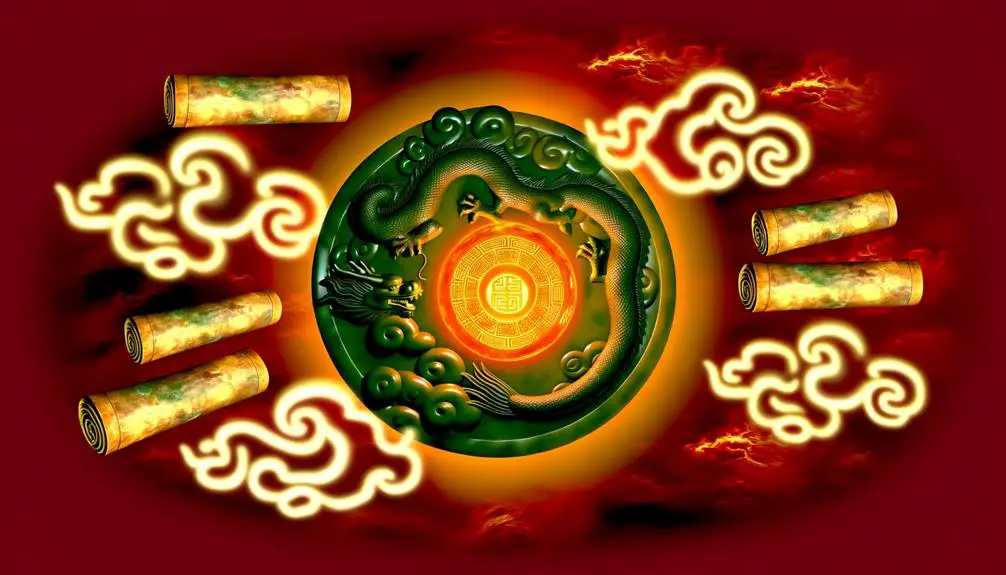
In the practice of Feng Shui, the dragon is revered as a powerful auspice, embodying potent energies that harmonize and enhance the spatial balance within an environment.
This celestial creature is often placed in homes or businesses to attract prosperity, protection, and good fortune. Positioned strategically, typically in the east sector or near water features, the dragon's presence is believed to channel positive chi (energy) flow.
Its integration into Feng Shui is deeply rooted in Chinese cosmology, where the dragon represents the yang (active) force. This dynamic symbol is also associated with courage, strength, and wisdom, encouraging occupants to pursue their goals with vigor.
Hence, the dragon's significance in Feng Shui extends beyond mere decor, influencing the very essence of spatial harmony.
Dragon Festivals
Dragon Festivals in China are a cornerstone of cultural heritage, prominently featuring celebratory Dragon Boat Races that attract both local and international participants. These events are imbued with deep cultural significance, reflecting ancient rituals and communal values that honor the mythical dragon as a symbol of prosperity and protection.
Rituals performed during these festivals, such as offering sacrifices and performing traditional dances, emphasize the dragon's revered status within Chinese society.
Celebratory Dragon Boat Races
Celebratory Dragon Boat Races, deeply ingrained in Chinese cultural heritage, are lively events that honor the legendary poet Qu Yuan and symbolize unity, strength, and cooperation. These races, often held during the Duanwu Festival, showcase intricately decorated boats resembling dragons, paddled by teams in rhythmic harmony. The spectacle is not just about athletic prowess but also cultural pride and communal spirit.
Key elements include:
- Ritualistic drumming: Essential for maintaining paddling rhythm.
- Elaborate decorations: Dragon heads and tails adorn boats.
- Community participation: Involves extensive local and international engagement.
- Traditional foods: Zongzi (sticky rice dumplings) are commonly consumed.
These races serve as a vibrant demonstration of China's rich cultural tapestry and the enduring legacy of its traditions.
Cultural Significance and Rituals
The cultural significance of dragon festivals in Chinese society extends beyond mere celebration, embodying profound values of reverence, mythology, and communal identity. These festivals, such as the Dragon Boat Festival, are imbued with rich traditions that pay homage to the mythical dragon, a symbol of power, strength, and good fortune.
Rituals such as dragon boat racing, the crafting of intricate dragon effigies, and the consumption of zongzi (glutinous rice wrapped in bamboo leaves) are integral to these events. They serve to foster communal bonds and instill a sense of shared heritage. These festivals are often synchronized with agricultural cycles, reflecting ancient practices meant to invoke favorable conditions for crops and to honor ancestors, reinforcing the dragon's auspicious significance.
Modern Cultural Impact

In contemporary China, the symbol of the dragon continues to play an integral role in various facets of cultural expression, ranging from traditional festivals to modern media representations. This revered emblem manifests in numerous ways, reflecting its enduring significance and adaptability:
- Festivals: Dragon dances and boat races are central to celebrations like the Lunar New Year and Dragon Boat Festival.
- Art and Design: Contemporary artists incorporate dragon motifs into paintings, sculptures, and fashion.
- Media: Films, television, and literature frequently invoke dragon imagery, symbolizing power and mystique.
- Corporate Branding: Businesses utilize dragon symbols to convey strength, prosperity, and good fortune.
These multifaceted applications underscore the dragon's deep-rooted presence in China's evolving cultural landscape.
Global Influence
As globalization continues to bridge cultural divides, the Chinese symbol of the dragon has transcended its traditional boundaries, exerting a profound influence on various global cultures and artistic expressions. In contemporary contexts, the dragon manifests in diverse mediums, from fashion to film, often symbolizing power, wisdom, and mysticism. Its adaptability highlights a rich cross-cultural dialogue and mutual appreciation.
| Medium | Region |
|---|---|
| Fashion | Western Europe |
| Film | North America |
| Literature | Latin America |
| Visual Arts | Southeast Asia |
The dragon's symbolism has been reinterpreted, merging with local mythologies and aesthetics, thereby enriching global cultural tapestries. This syncretism underscores the dragon's enduring allure and its capacity to inspire and unify across cultural frontiers.
Conclusion
To sum up, the Chinese symbol of the dragon weaves a rich tapestry of historical, mythological, and cultural significance, serving as a powerful emblem across various facets of Chinese life.
As a phoenix rising from the ashes, the dragon transcends mere symbolism, embodying the quintessence of strength, wisdom, and auspiciousness.
This iconic figure's enduring presence in art, literature, zodiac traditions, and modern cultural practices underscores its profound and far-reaching influence, both within China and across the globe.

